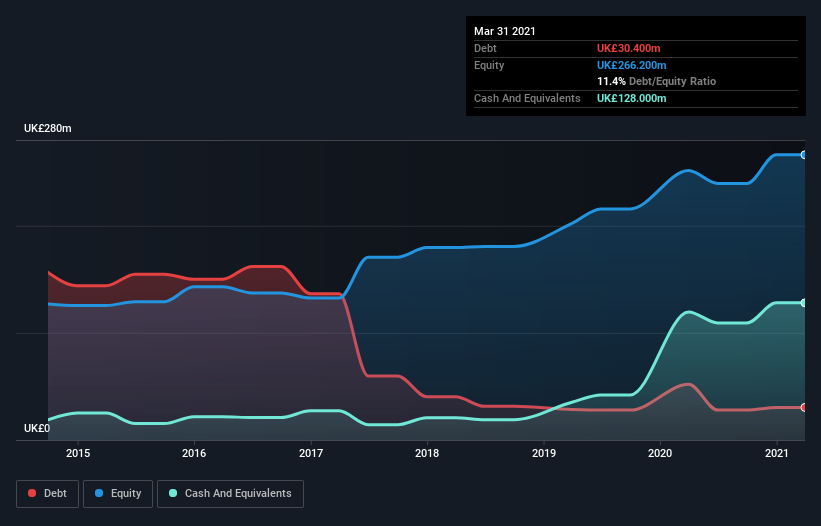Does Oxford Instruments (LON:OXIG) Have A Healthy Balance Sheet?
Legendary fund manager Li Lu (who Charlie Munger backed) once said, 'The biggest investment risk is not the volatility of prices, but whether you will suffer a permanent loss of capital.' When we think about how risky a company is, we always like to look at its use of debt, since debt overload can lead to ruin. We note that Oxford Instruments plc (LON:OXIG) does have debt on its balance sheet. But is this debt a concern to shareholders?
When Is Debt A Problem?
Debt and other liabilities become risky for a business when it cannot easily fulfill those obligations, either with free cash flow or by raising capital at an attractive price. Part and parcel of capitalism is the process of 'creative destruction' where failed businesses are mercilessly liquidated by their bankers. While that is not too common, we often do see indebted companies permanently diluting shareholders because lenders force them to raise capital at a distressed price. By replacing dilution, though, debt can be an extremely good tool for businesses that need capital to invest in growth at high rates of return. The first step when considering a company's debt levels is to consider its cash and debt together.
Check out our latest analysis for Oxford Instruments
What Is Oxford Instruments's Net Debt?
As you can see below, Oxford Instruments had UK£30.4m of debt at March 2021, down from UK£52.0m a year prior. But on the other hand it also has UK£128.0m in cash, leading to a UK£97.6m net cash position.
How Strong Is Oxford Instruments' Balance Sheet?
The latest balance sheet data shows that Oxford Instruments had liabilities of UK£174.0m due within a year, and liabilities of UK£10.5m falling due after that. Offsetting these obligations, it had cash of UK£128.0m as well as receivables valued at UK£73.4m due within 12 months. So it actually has UK£16.9m more liquid assets than total liabilities.
This state of affairs indicates that Oxford Instruments' balance sheet looks quite solid, as its total liabilities are just about equal to its liquid assets. So it's very unlikely that the UK£1.45b company is short on cash, but still worth keeping an eye on the balance sheet. Succinctly put, Oxford Instruments boasts net cash, so it's fair to say it does not have a heavy debt load!
Also good is that Oxford Instruments grew its EBIT at 15% over the last year, further increasing its ability to manage debt. There's no doubt that we learn most about debt from the balance sheet. But it is future earnings, more than anything, that will determine Oxford Instruments's ability to maintain a healthy balance sheet going forward. So if you want to see what the professionals think, you might find this free report on analyst profit forecasts to be interesting.
Finally, a business needs free cash flow to pay off debt; accounting profits just don't cut it. While Oxford Instruments has net cash on its balance sheet, it's still worth taking a look at its ability to convert earnings before interest and tax (EBIT) to free cash flow, to help us understand how quickly it is building (or eroding) that cash balance. Over the last three years, Oxford Instruments recorded free cash flow worth a fulsome 92% of its EBIT, which is stronger than we'd usually expect. That puts it in a very strong position to pay down debt.
Summing up
While we empathize with investors who find debt concerning, you should keep in mind that Oxford Instruments has net cash of UK£97.6m, as well as more liquid assets than liabilities. And it impressed us with free cash flow of UK£37m, being 92% of its EBIT. So is Oxford Instruments's debt a risk? It doesn't seem so to us. Another factor that would give us confidence in Oxford Instruments would be if insiders have been buying shares: if you're conscious of that signal too, you can find out instantly by clicking this link.
Of course, if you're the type of investor who prefers buying stocks without the burden of debt, then don't hesitate to discover our exclusive list of net cash growth stocks, today.
This article by Simply Wall St is general in nature. We provide commentary based on historical data and analyst forecasts only using an unbiased methodology and our articles are not intended to be financial advice. It does not constitute a recommendation to buy or sell any stock, and does not take account of your objectives, or your financial situation. We aim to bring you long-term focused analysis driven by fundamental data. Note that our analysis may not factor in the latest price-sensitive company announcements or qualitative material. Simply Wall St has no position in any stocks mentioned.
Have feedback on this article? Concerned about the content? Get in touch with us directly. Alternatively, email editorial-team (at) simplywallst.com.

 Yahoo Finance
Yahoo Finance 
